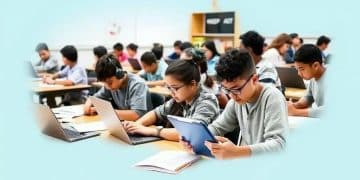Teacher AI tools 2025 trends in education

AI integration in schools enhances personalized learning, empowers teachers with tools for efficiency, and prepares students for future challenges, making classrooms more interactive and engaging.
Teacher AI tools 2025 trends are set to transform education as we know it. With technology evolving at a rapid pace, educators are faced with exciting opportunities to enhance their teaching strategies. Curious about what this means for your classroom? Let’s dive in!
Emerging AI tools for educators
As classrooms evolve, emerging AI tools for educators are becoming crucial. These tools help streamline teaching processes, making them more efficient and personalized. With technology advancing, it’s vital to explore how these innovations can impact learning environments.
What Are AI Tools?
AI tools encompass various technologies that assist in teaching and learning. They can analyze student performance and provide real-time feedback. The goal is to enhance educational outcomes through tailored approaches.
Benefits of AI Tools
There are numerous benefits of implementing AI tools in education:
- Personalization: Educators can offer lessons tailored to individual student needs.
- Efficiency: Administrative tasks can be automated, giving teachers more time for instruction.
- Engagement: Interactive tools keep students interested and motivated to learn.
- Data Analysis: Teachers gain insights into student performance, allowing for timely interventions.
In addition to those benefits, AI tools foster collaboration among teachers. Sharing resources and strategies becomes easier, creating a supportive community. This collective approach enhances overall teaching effectiveness.
Examples of AI Tools
Several AI tools have gained traction in classrooms. For instance, platforms like Google Classroom use AI to organize and streamline tasks. Similarly, Gradescope provides automated grading, ensuring timely feedback for students. Other tools like Carnegie Learning offer adaptive learning, adjusting content according to each student’s pace.
With the incorporation of these tools, educators are empowered to refine their teaching techniques. Embracing innovation allows for a more engaging and effective learning experience.
Impact of AI on teaching methods

The impact of AI on teaching methods is substantial. Educators are finding new ways to engage students and deliver content effectively. As AI becomes more integrated into classrooms, teaching strategies are adapting to utilize its capabilities.
Changing Roles of Educators
AI tools empower teachers by automating administrative tasks. This allows educators to focus on what they do best: teaching. For example, grading quizzes or tracking attendance can be managed by AI systems. As a result, teachers can spend more time planning lessons and interacting with students.
Enhanced Learning Experiences
AI also enriches the learner’s experience. By analyzing individual student data, AI can suggest personalized resources and activities. This means that students receive content suited to their unique learning styles. Some benefits include:
- Adaptive Learning: Tools adjust difficulty based on student progress.
- Immediate Feedback: Students get prompt responses, helping them improve quickly.
- Diverse Resources: AI provides access to various learning materials, catering to different interests.
- Collaborative Learning: AI facilitates group projects and peer interactions.
Incorporating AI means that lessons can be designed with flexibility in mind. Teachers can modify their approaches to suit diverse classrooms. The use of interactive tools encourages participation, making learning fun and engaging.
Furthermore, AI tools assist in identifying at-risk students early on. Teachers can receive alerts about students who may need additional support. This proactive approach can help ensure that no student falls behind.
Innovative Teaching Practices
As AI technologies advance, new teaching practices emerge. Gamification and virtual reality are becoming popular in education. These methods increase motivation and offer unique learning opportunities. Using AI, teachers can create immersive experiences that capture student interest.
Overall, the integration of AI into teaching methods is changing how education is delivered. By embracing these innovations, educators can enhance their effectiveness and inspire students in new ways.
How AI can personalize student learning
How AI can personalize student learning is one of the most exciting developments in education. By using data and analytics, AI can create tailored learning experiences for each student. This personalization helps meet individual needs and promotes better outcomes.
Understanding Student Needs
AI systems collect and analyze data on student performance and learning styles. This information is invaluable. For instance, if a student struggles with a specific topic, AI can recommend extra practice or different resources. This ensures that learning is effective and focused.
Adaptive Learning Platforms
Many schools are adopting adaptive learning platforms. These tools adjust the content based on how well students understand the material. Some advantages include:
- Real-time Adjustments: Content is modified instantly, providing the right level of challenge.
- Progress Tracking: Teachers can easily monitor student progress and identify areas needing attention.
- Self-Paced Learning: Students can learn at their own speed, reducing frustration and enhancing confidence.
- Custom Learning Paths: AI creates unique pathways that cater to individual interests and strengths.
This personalized approach allows students to engage more deeply with their studies. When lessons align with a student’s interests, motivation increases, leading to better retention of information.
Moreover, AI can help teachers design targeted interventions. By identifying students who may require additional help, educators can provide support promptly. This proactive strategy not only boosts performance but also fosters a positive learning environment.
Enhancing Engagement and Collaboration
AI also enhances engagement through interactive tools such as chatbots and virtual tutors. These resources are available 24/7, encouraging students to ask questions outside of classroom hours. Additionally, group projects facilitated by AI can help students learn from each other, making learning more collaborative.
Through the personalization of learning, AI empowers both students and teachers. By adopting these technologies, educators can create more meaningful and effective educational experiences, shaping the future of learning.
Preparing for AI integration in schools

Preparing for AI integration in schools is an essential step for educators and administrators. As technology evolves, schools must adapt to effectively use AI tools that enhance the learning experience. This involves thoughtful planning and training.
Training Educators
Teachers need proper training to utilize AI effectively. Professional development programs can provide insights into how AI can support instruction. Some key areas of focus include:
- Understanding AI Tools: Familiarity with specific tools available for classroom use.
- Data Privacy: Knowing how to protect student information when using AI technologies.
- Integration Strategies: Learning best practices for incorporating AI into lesson plans.
- Collaboration: Opportunities for teachers to share experiences and strategies.
With ongoing training, educators can feel confident in their ability to implement AI effectively. This confidence translates to better learning experiences for students.
Infrastructure and Resources
Schools must also ensure that they have the right infrastructure in place. Reliable internet access and updated hardware are crucial for AI applications to function smoothly. Additionally, investing in educational resources is vital. These resources should be accessible to all students, promoting equity in learning opportunities.
School leaders should assess the current technology landscape and identify areas needing improvement. Involving teachers in this assessment fosters a team environment and helps pinpoint specific needs within classrooms.
Developing a Strategic Plan
A strategic plan for AI integration should outline goals and timelines for implementation. This plan can help guide decision-making and prioritize initiatives. Some important steps include defining clear objectives, seeking stakeholder input, and evaluating the impact of AI on student learning.
With a comprehensive approach that includes training, infrastructure, and strategic planning, schools can set the stage for successful AI integration. Embracing this technology not only prepares students for the future, but also empowers educators in their roles.
FAQ – Questions about AI Integration in Schools
What are the benefits of AI in education?
AI can personalize learning experiences, allowing students to learn at their own pace and receive tailored resources.
How can teachers prepare for AI integration?
Teachers can participate in training programs to understand AI tools and learn best practices for using them in the classroom.
What infrastructure is needed for AI tools?
Schools need reliable internet access and updated hardware to ensure AI applications run smoothly.
How does AI promote collaboration among students?
AI can facilitate group projects and interactions, encouraging students to work together in a more engaging way.





